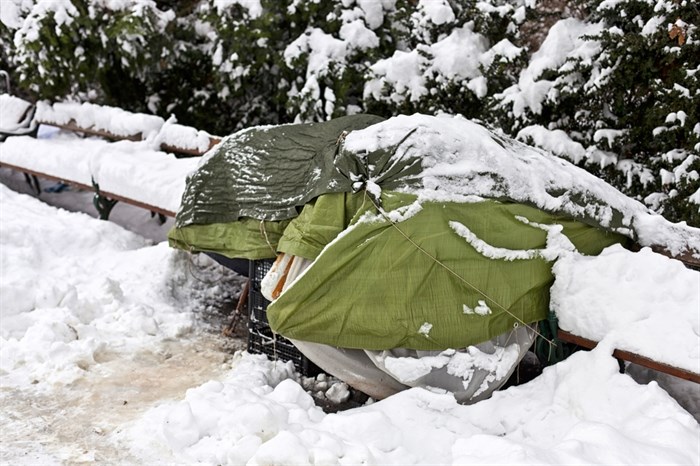
Image Credit: Shutterstock
November 23, 2023 - 7:24 AM
Kelowna is expecting 120 tiny homes, or “sleeper units” in mid-December, ready to be installed across two locations in the city but with winter approaching, this won't be enough to house the current homeless population.
Colleen Cornock, Social Development Manager at the City of Kelowna, told iNFOnews.ca the city is aware they won't solve any problems.
“(We) fully recognize that the number of units... won't meet our current needs,” Cornock said. “So, our extreme weather planning will resemble much the same as what we worked with not-for-profits and BC Housing last year.”
This includes the distribution of warming supplies, such as toques, gloves, hand warmers, socks, tents, and sleeping bags to homeless people.
The initiative is called Homeless Encampment Action Response Temporary Housing or HEARTH and will see 60 units installed in the North End of the city, on Crowley Avenue. These will come together to create a tiny house village, with separate cooking spaces and washrooms. Each individual unit is about 60 square feet and comes with a bed and dresser.
READ MORE: Why Kelowna’s homeless don’t get bathrooms in their new tiny shelters
The second location will be constructed as a workforce-style housing unit, similar to ATCO work trailers, Cornock said.
It is unclear when the units will be fully operational as an operator still needs to be secured by BC Housing before that can happen.
READ MORE: 120 tiny houses planned for homeless people in Kelowna
Until then, the city will also be deploying the thermal shelters it purchased last year. These shelters are made from individual, interlocking foam material that slot together, much like a tent.
Cornock said the city also plans to use warming buses, like it did last year, to provide an overnight reprieve from the cold.
READ MORE: Warming bus new stop-gap measure to help homeless during Kelowna cold snap
“We're planning for multiple buses, both stationary and mobile,” she said.
The number and availability of the buses will be determined by the funding provided by BC housing, which is still in negotiation.
“We're working with BC Housing right now to determine whether or not there are funds available for this particular project,” she said.
Last year, the city worked with an organization that supplied private buses. The buses were then parked at an overnight sheltering location, where residents could take a seat with the heating turned on and wait out the cold night.
“We are exploring the opportunity this year where (buses) would be in multiple locations,” Cornock said. “So, mobile (and) recognising that not all those residing outside are in the downtown core.”
Cornock said the city is working with non-profits and a lived experience group to determine where these buses should go.
“It's a bit early to tell right now whereabouts those will be, but it will be a fluid situation so that we can respond as new spots pop up,” she said.
Last year, Okanagan not-for-profits released a letter expressing their frustration at bearing the brunt of the winter homelessness crisis and petitioned the city and BC housing to do more to lighten their load.
READ MORE: Interior Health responds to shelter crisis as Thompson Okanagan non-profits fed up with situation
Cornock said she has personally made efforts to connect with the not-for-profit sector and hear their needs. She also said operators are in contact with the mayor about their capacity constraints.
“I think that is something that we have different this year than we've had in previous years,” Cornock said. “We fully recognize that they (non-profits) are dealing with considerable constraints within their sector in terms of securing staff and meeting the training requirements that are necessary to deal with a complex community, and we'll certainly continue to work with them as best we can to support their efforts.”
The new sleeper units, collaboration with non-profits and proactive wellness checks and distribution of warming supplies has hopefully better prepared the city for this winter's homelessness, Cornock said.
“Also, with 120 new units, both the two different sites, that puts us in a better position,” she said. “However, we’re also recognising that the numbers of the individuals that are currently sleeping outside has exceeded those numbers from last year.”
To contact a reporter for this story, email Georgina Whitehouse or call 250-864-7494 or email the editor. You can also submit photos, videos or news tips to the newsroom and be entered to win a monthly prize draw.
We welcome your comments and opinions on our stories but play nice. We won't censor or delete comments unless they contain off-topic statements or links, unnecessary vulgarity, false facts, spam or obviously fake profiles. If you have any concerns about what you see in comments, email the editor in the link above. SUBSCRIBE to our awesome newsletter here.
News from © iNFOnews, 2023